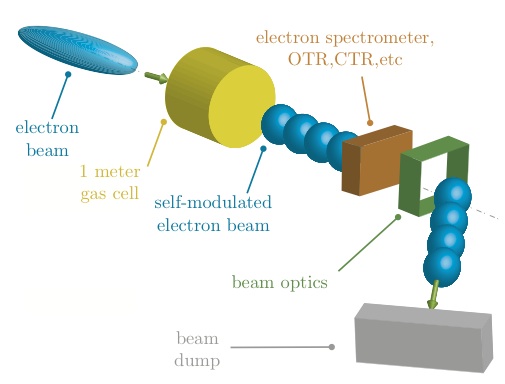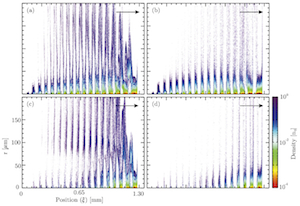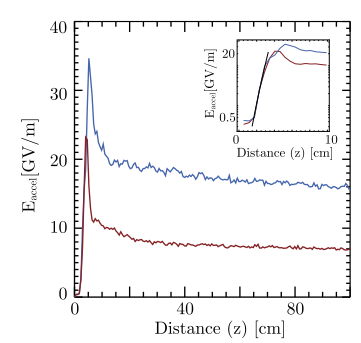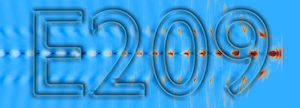|
-
E209 is an e-/e+-bunch self-modulation experiment at the SLAC-FACET National User Facility
It is a collaboration between groups at the following institutions:
-
Background
The self-modulation of long (when compared to the plasma wave wavelength λpe) charged particle bunches has recently been identified as a means of driving
large amplitude wakefields in dense plasmas [Kumar, Phys. Rev. Lett. 104, 255003 (2010)].
The self-modulation of the long bunch occurs because of the low level transverse wakefields initially driven by the long bunch.
This periodic focusing/defocusing leads to a modulation of the bunch density along its axis, which in turns leads to larger wakefields amplitude.
This feedback mechanism drives the development of the self-modulation instability (SMI).
After saturation of the SMI the periodically modulated (period ~λpe) train of bunches (length~λpe/2) resonantly drives wakefields over long plasma lengths.
The formation of short bunches through the SMI allows in principle to use the very large energy (6 and 112kJ in 1011 particles) carried by proton bunches produced,
for example, by the CERN
SPS (400GeV) or
LHC (7TeV) for e- and e+ acceleration.
An experiment known as AWAKE has recently been
proposed to test this acceleration method with proton bunches.
We
proposed the E209 experiment to the SAREC committee in 2012.
The committee approved the experiment.
-
Goal of the E209 Experiment
The goal of the E209 experiment is to test the physics of the self-modulation of negatively (e-) and positively (e+) charged particle bunches in long plasmas [Vieira, Phys. Plasmas 19, 063105 (2012)].
The experiment takes advantage of the availability of these bunches and of a meter scale plasma at the
FACET User Facility.
-
A Schematic of the Experiment

A schematic of the experiment is shown here for the case of an e- bunch [from
Vieira, IPAC 2012 proceedings].
The long, smooth e- bunch (blue, coming from the left) enters the plasma (yellow).
Inside the plasma the SMI self-modulates the bunch density.
The bunch exits the plasma with a longitudinally periodic modulation (the bunch is now shown as blue spheres) due to the alternating focusing/defocusing of the wakefields.
It is important to note that because the bunch particles are relativistic there is no longitudinal bunching.
The modulation is a purely transverse phenomenon with a longitudinal period.
In this schematic the bunch is ~4λpe-long.
Each bunch is ~λpe/2-long (not shown here) for the case of a e- bunch and less for a for the case of a e+ bunch.
The bunch traverses various screens placed downstream of the plasma where it can emit incoherent (λ≪λpe) optical transition radiation (OTR) or coherent (λ≫λpe) transition radiation (CTR).
In particular, CTR interferometry can be used to measure the longitudinally-periodic radial modulation.
The bunch then travels trough an imaging magnetic spectrometer (consisting of dipole and quadrupole magnets, green "beam optics") on its way to the dump.
The energy change imparted on the (drive) bunch particles can be measured.
Since the longitudinal wakefields reach large amplitudes (>10GV/m, see below) and the plasma is long (~1m) significant energy gain and loss can occur (see below).
No witness particles are externally injected into the wakefields in this experiment.
-
Self-modulation of e- and e+ Bunches

Plasma e- respond to the bunch fields faster that the ions that are much heavier (the ions are "immobile").
This is however not always the case (see [Vieira, Phys. Rev. Lett. 109, 145005 (2012)].
In the linear plasma wakefield regime, where the plasma density perturbation (δne0) is small (δne0≪ne0) when compared to the initial density (ne0), the response of the plasma to a e- or e+ bunch is symmetric.
However, when the nonlinear regime is reached, the wakefields have a structure with focusing regions (the "ion column" in the blowout regime) much larger for e- than for e+.
The consequences of this difference have been observed in previous experiments [Muggli, Phys. Rev. Lett. 101, 055001 (2008)].
As a results, more e+ than e- are defocused and lost along the plasma, as shown on the figure [from Vieira, Phys. Plasmas 19, 063105 (2012)].
The top figures are for e-, while the bottom ones are for e+.
The left hand side pictures are after a short distance into the plasma (z=10cm), and there are approximately the same number of particles in the two bunches.
The two figure are somewhat similar at this point.
The right hand side pictures are after 1m, and there are much fewer e+ than e-.
The wakefields are much more nonlinear after 1m than after 10cm.
Note the large radial position of the periodically defocused particles.
-
Accelerating Fields

As shown here above, the self-modulation occurs for e-and e+ bunches, however, somewhat differently with the parameters of E209.
As a result, the maximum accelerating field amplitude obtained along the plasma is also different, as shown on this figure [from Vieira, Phys. Plasmas 19, 063105 (2012)].
Initially (z<5cm), as the SMI develops, the fields are very similar (linear plasma wakefield regime).
However, close to saturation, when the wakefields become nonlinear, larger fields are reached with e- (blue curve) than with e+ (red curve).
In both cases though, the field amplitudes are very large, >10GV/m!
The decrease of the fields after the SMI saturation (z>10cm) is due to the continuous evolution of the wakefields and bunch density.
The inset show the detail of the few centimeters of propagation where the SMI grows.
The lines are calculated growth rates.
Note that what is "traditionally" plotted is the peak electric field along the bunch as a function of propagation distance (as on the figure).
However, the position of this peak may vary along the propagation distance and the energy gain/loss by bunch particles may be substantially smaller than the integral of this field (Egain,loss=∫Ezdz≤∫Ez,max,mindz).
-
Energy Gain/loss
Since the evolution of the bunches along the plasma and the maximum wakefield amplitude are different,
the energy gain and loss by the bunch particles are also different for e- (blue curve) and e+ (red curve), as shown on this figure [from Vieira, Phys. Plasmas 19, 063105 (2012)].
These kinds of large energy gain and loss should be easily detectable with the FACET spectrometer.
The incoming particles energy is 20GeV in these simulations.
-
Seeding of the Instability (SMI)

In general an instability starts from "noise".
The noise level is often low, the starting signal random, leading to a long plasma length for the instability to saturate and to an unknown wakefield phase with respect to the drive bunch.
In this case it is impossible to predictably inject witness particles in the accelerating and focusing phase of the wakefields.
The SMI can be seeded to reduce the length needed to reach saturation and to fix the initial phase of the wakefields.
There are different methods for seeding the SMI, seeding through shaping of the particle bunch is available at FACET.
The bunch is cut using a collimation technique that was demonstrated at the
Brookhaven National Laboratory
Accelerator Test Facility
[Muggli, Phys. Rev. Lett. 101, 054801 (2008)].
Seeding the SMI also tends to suppress a competing transverse instability, the hose instability that can break up the bunch before the SMI saturates and before energy gain can occur.
This is visible on the figure, where in the case of the full bunch without SMI seeding (left hand side) the bunch is strongly asymmetrically distorted.
In the case of SMI seed with a "half-cut" bunch no sign of hosing is visible [right hand side case from Vieira, Phys. Plasmas 19, 063105 (2012)].
The bunch propagates to the right.
-
Parameters
The table shows the parameters that were used for (most of) the simulation results presented here [see Vieira, Phys. Plasmas 19, 063105 (2012) for details].
These parameters are generic and the physics observed weakly dependent on the actual parameters.
The "official" beam parameters reached at FACET can be found here.
-
Additional Information
Additional information can be found in the original publication (and others, see below):
J. Vieira, Y. Fang, W.B. Mori, L. O. Silva and P. Muggli, "Transverse self-modulation of ultra-relativistic lepton beams in the plasma wakefield accelerator", Phys. Plasmas 19, 063105 (2012).
All simulations performed with OSIRIS [Fonseca, Lect. Notes Comp. Sci. vol. 2331/2002, (Springer Berlin / Heidelberg,(2002)].
-
-
Schedule
The E209 experiment is tentatively scheduled for the next run, starting October 1, 2013.
-
Contact
The E209 PIs can be contacted at:
j o r g e . v i e i r a @ist.utl.pt (Jorge Vieira, IST)
m u g g l i @mpp.mpg.de (Patric Muggli, MPP)
-
E209 Publications
J. Vieira, O. Reimann, N.C. Lopes, L.O. Silva, E. Adli, S.J. Gessner, M.J. Hogan, S.Z. Li, M.D. Litos, Y. Fang, C. Joshi, K.A. Marsh, W.B. Mori, N. Vafaei, "Self-Modulation and Hosing Instability of SLAC Electron and Positron Bunches in Plasmas", Proceedings of the International Particle Accelerator Conference (IPAC 2013), 2013.
P. Muggli, J. Vieira, L.O. Silva, W.B. Mori, Y. Fang, M.J. Hogan, "Self-modulation of Long Particle Bunches in Plasmas at SLAC", Proceedings of the International Particle Accelerator Conference (IPAC 2012), 2831 2012.
P. Muggli, B. Allen, Y. Fang, V. Yakimenko, M. Babzien, K. Kusche, M. Fedurin, J. Vieira, J. Martins, and L. Silva, "Three regimes of relativistic beam-plasma interaction", AIP Conf. Proc. 1507, 594 (2012).
J. Vieira, Y. Fang, W.B. Mori, L. O. Silva and P. Muggli, "Transverse self-modulation of ultra-relativistic lepton beams in the plasma wakefield accelerator", Phys. Plasmas 19, 063105 (2012).
-
Links
AWAKE experiment at CERN.
AWAKE at the Max Planck Institute of Physics (MPP), Munich.
-
Some Related Publications
Y. Fang et al., "Seeding of the Self-modulation Instability of a long Electron Bunch in a Plasma", Phys. Rev. Lett. 112, 045001 (2014).
E. Oz et al., "A novel Rb vapor plasma source for plasma wakefield accelerators", to appear in Nucl. Inst. Meth. in Phys. Res. A (available online) (2013).
O. Reimann, R. Tarkeshian, "Dispersive Fourier-Transform Electrooptical Sampling For Single-Shot Modulation Measurement In A Proton-Driven Plasma Wakefield Accelerator", IBIC Proceedings 2013, p. 467.
W. An et al., "Strategies for mitigating the ionization-induced beam head erosion problem in an electron-beam-driven plasma wakefield accelerator", Phys. Rev. ST Accel. Beams 16, 101301 (2013).
R. Tarkeshian et al., "High Sensitivity Plasma Electron Density Measurements in Sources for a Proton-Driven Plasma Wakefield Accelerator", Proceedings of 40th EPS Plasma Physics and Controlled Fusion Conference, p. 4.210 (2013).
B. Buttenschoen et al., "A helicon plasma source as a prototype for a proton-driven plasma wakefield accelerator, Proc. EPS Conference on Plasma Physics and Controlled Fusion 2013, p. 2.208 (2013).
K. V. Lotov et al., "Effect of plasma inhomogeneity on plasma wakefield acceleration driven by long bunches", Phys. Plasmas 20, 013102 (2013).
C. B. Schroeder et al., "Coherent seeding of self-modulated plasma wakefield accelerators", Phys. Plasmas 20, 056704 (2013).
J. Vieira, O. Reimann, N.C. Lopes, L.O. Silva, E. Adli, S.J. Gessner, M.J. Hogan, S.Z. Li, M.D. Litos, Y. Fang, C. Joshi, K.A. Marsh, W.B. Mori, N. Vafaei, "Self-Modulation and Hosing Instability of SLAC Electron and Positron Bunches in Plasmas", Proceedings of the International Particle Accelerator Conference (IPAC 2013), 2013.
P. Muggli, J. Vieira, L.O. Silva, W.B. Mori, Y. Fang, M.J. Hogan, "Self-modulation of Long Particle Bunches in Plasmas at SLAC", Proceedings of the International Particle Accelerator Conference (IPAC 2012), 2831 2012.
P. Muggli, B. Allen, Y. Fang, V. Yakimenko, M. Babzien, K. Kusche, M. Fedurin, J. Vieira, J. Martins, and L. Silva, "Three regimes of relativistic beam-plasma interaction", AIP Conf. Proc. 1507, 594 (2012).
J. Vieira, Y. Fang, W.B. Mori, L. O. Silva and P. Muggli, "Transverse self-modulation of ultra-relativistic lepton beams in the plasma wakefield accelerator", Phys. Plasmas 19, 063105 (2012).
J. Vieira et al. "Ion Motion in Self-Modulated Plasma Wakefield Accelerators", Phys. Rev. Lett. 109, 145005 (2012).
K. V. Lotov et al., "Natural noise and external wakefield seeding in a proton-driven plasma accelerator", Phys. Rev. ST Accel. Beams 16, 041301 (2013).
A. Pukov et al. "Principles of self-modulated proton driven plasma wake field acceleration", AIP Conf. Proc. 1507, 103 (2012).
K. V. Lotov, "Optimum angle for side injection of electrons into linear plasma wakefields", Journal of Plasma Physics 78(04), 455 (2012).
A. Pukhov et al., "Transverse coherent transition radiation for diagnosis of modulated proton bunches", Phys. Rev. ST Accel. Beams 15, 111301 (2012).
A. Caldwell et al., "Plasma wakefield acceleration with a modulated proton bunch", Phys. Plasmas 18, 103101 (2011).
A. Pukhov et al., "Phase Velocity and Particle Injection in a Self-Modulated Proton-Driven Plasma Wakefield Accelerator", Phys. Rev. Lett. 107, 145003 (2011).
C. B. Schroeder et al., "Growth and Phase Velocity of Self-Modulated Beam-Driven Plasma Waves", Phys. Rev. Lett. 107, 145002 (2011).
N. Kumar et al., "Self-Modulation Instability of a Long Proton Bunch in Plasmas", Phys. Rev. Lett. 104, 255003 (2010).
|
|





